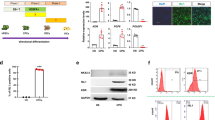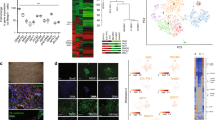Abstract
The endothelium covering the aortic, pulmonary, mitral, and tricuspid valves looks much like the endothelium throughout the vasculature, in terms of general morphology and expression of many endothelial markers. Closer examination, however, reveals important differences and hints of a unique phenotype that reflects the valvular endothelium's embryonic history, and potentially, its ability to maintain integrity and function over a life span of dynamic mechanical stress. A well-studied property that sets the cardiac valvular endothelium apart is the ability to transition from an endothelial to a mesenchymal phenotype—an event known as epithelial to mesenchymal transition (EMT). EMT is a critical step during embryonic valvulogenesis, it can occur in post-natal valves and has recently been implicated in the adaptive response of mitral valve leaflets exposed to a controlled in vivo setting designed to mimic the leaflet tethering that occurs in ischemic mitral regurgitation. In this review, we will discuss what is known about valvular endothelial cells, with a particular focus on post-natal, adult valves. We will put forth the idea that at subset of valvular endothelial cells are progenitor cells, which may serve to replenish valvular cells during normal cellular turnover and in response to injury and disease.







Similar content being viewed by others
References
Lincoln, J., Alfieri, C. M., & Yutzey, K. E. (2004). Development of heart valve leaflets and supporting apparatus in chicken and mouse embryos. Developmental Dynamics, 230, 239–250.
de Lange, F. J., Moorman, A. F., Anderson, R. H., Manner, J., Soufan, A. T., de Gier-de Vries, C., et al. (2004). Lineage and morphogenetic analysis of the cardiac valves. Circulation Research, 95, 645–654.
Liu, A. C., Joag, V. R., & Gotlieb, A. I. (2007). The emerging role of valve interstitial cell phenotypes in regulating heart valve pathobiology. American Journal of Pathology, 171, 1407–1418.
Maron, B. J., & Hutchins, G. M. (1974). The development of the semilunar valves in the human heart. American Journal of Pathology, 74, 331–344.
Hurle, J. M. (1979). Scanning and light microscope studies of the development of the chick embryo semilunar heart valves. Anatomy and Embryology, 157, 69–80.
Hurle, J. M., Colvee, E., & Blanco, A. M. (1980). Development of mouse semilunar valves. Anatomy and Embryology, 160, 83–91.
Hurle, J. M., & Colvee, E. (1983). Changes in the endothelial morphology of the developing semilunar heart valves. A tem and sem study in the chick. Anatomy and Embryology, 167, 67–83.
Deck, J. D. (1986). Endothelial cell orientation on aortic valve leaflets. Cardiovascular Research, 20, 760–767.
Butcher, J. T., Penrod, A. M., Garcia, A. J., & Nerem, R. M. (2004). Unique morphology and focal adhesion development of valvular endothelial cells in static and fluid flow environments. Arteriosclerosis, Thrombosis, and Vascular Biology, 24, 1429–1434.
Simmons, C. A., Grant, G. R., Manduchi, E., & Davies, P. F. (2005). Spatial heterogeneity of endothelial phenotypes correlates with side-specific vulnerability to calcification in normal porcine aortic valves. Circulation Research, 96, 792–799.
Butcher, J. T., Tressel, S., Johnson, T., Turner, D., Sorescu, G., Jo, H., et al. (2006). Transcriptional profiles of valvular and vascular endothelial cells reveal phenotypic differences: influence of shear stress. Arteriosclerosis, Thrombosis, and Vascular Biology, 26, 69–77.
Guerraty, M. A., Grant, G. R., Karanian, J. W., Chiesa, O. A., Pritchard, W. F., & Davies, P. F. (2010). Hypercholesterolemia induces side-specific phenotypic changes and peroxisome proliferator-activated receptor-gamma pathway activation in swine aortic valve endothelium. Arteriosclerosis, Thrombosis, and Vascular Biology, 30, 225–231.
Sucosky, P., Balachandran, K., Elhammali, A., Jo, H., & Yoganathan, A. P. (2009). Altered shear stress stimulates upregulation of endothelial vcam-1 and icam-1 in a bmp-4- and tgf-beta1-dependent pathway. Arteriosclerosis, Thrombosis, and Vascular Biology, 29, 254–260.
Aikawa, E., Whittaker, P., Farber, M., Mendelson, K., Padera, R. F., Aikawa, M., et al. (2006). Human semilunar cardiac valve remodeling by activated cells from fetus to adult: Implications for postnatal adaptation, pathology, and tissue engineering. Circulation, 113, 1344–1352.
Chi, J. T., Chang, H. Y., Haraldsen, G., Jahnsen, F. L., Troyanskaya, O. G., Chang, D. S., et al. (2003). Endothelial cell diversity revealed by global expression profiling. Proceedings of the National Academy of Sciences of the United States of America, 100, 10623–10628.
Johnson, C. M., & Fass, D. N. (1983). Porcine cardiac valvular endothelial cells in culture. A relative deficiency of fibronectin synthesis in vitro. Laboratory Investigation, 49, 589–598.
Johnson, C. M., & Helgeson, S. C. (1993). Fibronectin biosynthesis and cell-surface expression by cardiac and non-cardiac endothelial cells. American Journal of Pathology, 142, 1401–1408.
Simon, A., Zavazava, N., Sievers, H. H., & Muller-Ruchholtz, W. (1993). In vitro cultivation and immunogenicity of human cardiac valve endothelium. Journal of Cardiac Surgery, 8, 656–665.
Markwald, R. R., Fitzharris, T. P., & Manasek, F. J. (1977). Structural development of endocardial cushions. The American Journal of Anatomy, 148, 85–119.
Markwald, R. R., Fitzharris, T. P., & Smith, W. N. (1975). Structural analysis of endocardial cytodifferentiation. Developmental Biology, 42, 160–180.
Krug, E. L., Runyan, R. B., & Markwald, R. R. (1985). Protein extracts from early embryonic hearts initiate cardiac endothelial cytodifferentiation. Developmental Biology, 112, 414–426.
Markwald, R., Eisenberg, C., Eisenberg, L., Trusk, T., & Sugi, Y. (1996). Epithelial-mesenchymal transformations in early avian heart development. Acta Anatomica, 156, 173–186.
Sugi, Y., Yamamura, H., Okagawa, H., & Markwald, R. R. (2004). Bone morphogenetic protein-2 can mediate myocardial regulation of atrioventricular cushion mesenchymal cell formation in mice. Developmental Biology, 269, 505–518.
Ma, L., Lu, M. F., Schwartz, R. J., & Martin, J. F. (2005). Bmp2 is essential for cardiac cushion epithelial-mesenchymal transition and myocardial patterning. Development, 132, 5601–5611.
Rivera-Feliciano, J., & Tabin, C. J. (2006). Bmp2 instructs cardiac progenitors to form the heart-valve-inducing field. Developmental Biology, 295, 580–588.
Brown, C. B., Boyer, A. S., Runyan, R. B., & Barnett, J. V. (1996). Antibodies to the type ii tgfbeta receptor block cell activation and migration during atrioventricular cushion transformation in the heart. Developmental Biology, 174, 248–257.
Person, A. D., Klewer, S. E., & Runyan, R. B. (2005). Cell biology of cardiac cushion development. International Review of Cytology, 243, 287–335.
Liebner, S., Cattelino, A., Gallini, R., Rudini, N., Iurlaro, M., Piccolo, S., et al. (2004). Beta-catenin is required for endothelial-mesenchymal transformation during heart cushion development in the mouse. The Journal of Cell Biology, 166, 359–367.
Timmerman, L. A., Grego-Bessa, J., Raya, A., Bertran, E., Perez-Pomares, J. M., Diez, J., et al. (2004). Notch promotes epithelial-mesenchymal transition during cardiac development and oncogenic transformation. Genes & Development, 18, 99–115.
Combs, M. D., & Yutzey, K. E. (2009). Heart valve development: regulatory networks in development and disease. Circulation Research, 105, 408–421.
Lincoln, J., & Yutzey, K. E. (2011). Molecular and developmental mechanisms of congenital heart valve disease. Birth Defects Research. Part A, Clinical and Molecular Teratology, 91, 526–534.
Paranya, G., Vineberg, S., Dvorin, E., Kaushal, S., Roth, S. J., Rabkin, E., et al. (2001). Aortic valve endothelial cells undergo transforming growth factor-beta-mediated and non-transforming growth factor-beta-mediated transdifferentiation in vitro. American Journal of Pathology, 159, 1335–1343.
Paruchuri, S., Yang, J. H., Aikawa, E., Melero-Martin, J. M., Khan, Z. A., Loukogeorgakis, S., et al. (2006). Human pulmonary valve progenitor cells exhibit endothelial/mesenchymal plasticity in response to vascular endothelial growth factor-a and transforming growth factor-beta2. Circulation Research, 99, 861–869.
Yang, J. H., Wylie-Sears, J., & Bischoff, J. (2008). Opposing actions of notch1 and vegf in post-natal cardiac valve endothelial cells. Biochemical and Biophysical Research Communications, 374, 512–516.
Chaput, M., Handschumacher, M. D., Tournoux, F., Hua, L., Guerrero, J. L., Vlahakes, G. J., et al. (2008). Mitral leaflet adaptation to ventricular remodeling: occurrence and adequacy in patients with functional mitral regurgitation. Circulation, 118, 845–852.
Dal-Bianco, J. P., Aikawa, E., Bischoff, J., Guerrero, J. L., Handschumacher, M. D., Sullivan, S., et al. (2009). Active adaptation of the tethered mitral valve: Insights into a compensatory mechanism for functional mitral regurgitation. Circulation, 120, 334–342.
Lincoln, J., Lange, A. W., & Yutzey, K. E. (2006). Hearts and bones: shared regulatory mechanisms in heart valve, cartilage, tendon, and bone development. Developmental Biology, 294, 292–302.
Pittenger, M. F., Mackay, A. M., Beck, S. C., Jaiswal, R. K., Douglas, R., Mosca, J. D., et al. (1999). Multilineage potential of adult human mesenchymal stem cells. Science, 284, 143–147.
Wylie-Sears, J., Aikawa, E., Levine, R. A., Yang, J. H., & Bischoff, J. (2011). Mitral valve endothelial cells with osteogenic differentiation potential. Arteriosclerosis, Thrombosis, and Vascular Biology, 31, 598–607.
Melero-Martin, J. M., Khan, Z. A., Picard, A., Wu, X., Paruchuri, S., & Bischoff, J. (2007). In vivo vasculogenic potential of human blood-derived endothelial progenitor cells. Blood, 109, 4761–4768.
Ingram, D. A., Mead, L. E., Tanaka, H., Meade, V., Fenoglio, A., Mortell, K., et al. (2004). Identification of a novel hierarchy of endothelial progenitor cells using human peripheral and umbilical cord blood. Blood, 104, 2752–2760.
Kraling, B. M., & Bischoff, J. (1998). A simplified method for growth of human microvascular endothelial cells results in decreased senescence and continued responsiveness to cytokines and growth factors. In Vitro Cellular & Developmental Biology–Animal, 34, 308–315.
Rajamannan, N. M., Subramaniam, M., Rickard, D., Stock, S. R., Donovan, J., Springett, M., et al. (2003). Human aortic valve calcification is associated with an osteoblast phenotype. Circulation, 107, 2181–2184.
Chen, J. H., Yip, C. Y., Sone, E. D., & Simmons, C. A. (2009). Identification and characterization of aortic valve mesenchymal progenitor cells with robust osteogenic calcification potential. American Journal of Pathology, 174, 1109–1119.
Osman, L., Yacoub, M. H., Latif, N., Amrani, M., & Chester, A. H. (2006). Role of human valve interstitial cells in valve calcification and their response to atorvastatin. Circulation, 114, I547–552.
Bouchard-Martel, J., Roussel, E., Drolet, M. C., Arsenault, M., & Couet, J. (2009). Interstitial cells from left-sided heart valves display more calcification potential than from right-sided valves: an in-vitro study of porcine valves. The Journal of Heart Valve Disease, 18, 421–428.
Aikawa, E., Nahrendorf, M., Sosnovik, D., Lok, V. M., Jaffer, F. A., Aikawa, M., et al. (2007). Multimodality molecular imaging identifies proteolytic and osteogenic activities in early aortic valve disease. Circulation, 115, 377–386.
Arciniegas, E., Sutton, A. B., Allen, T. D., & Schor, A. M. (1992). Transforming growth factor beta 1 promotes the differentiation of endothelial cells into smooth muscle-like cells in vitro. Journal of Cell Science, 103(Pt 2), 521–529.
Frid, M. G., Kale, V. A., & Stenmark, K. R. (2002). Mature vascular endothelium can give rise to smooth muscle cells via endothelial-mesenchymal transdifferentiation: in vitro analysis. Circulation Research, 90, 1189–1196.
Ishisaki, A., Hayashi, H., Li, A. J., & Imamura, T. (2003). Human umbilical vein endothelium-derived cells retain potential to differentiate into smooth muscle-like cells. Journal of Biological Chemistry, 278, 1303–1309.
Dudley, A. C., Khan, Z. A., Shih, S. C., Kang, S. Y., Zwaans, B. M., Bischoff, J., et al. (2008). Calcification of multipotent prostate tumor endothelium. Cancer Cell, 14, 201–211.
Zeisberg, E. M., Tarnavski, O., Zeisberg, M., Dorfman, A. L., McMullen, J. R., Gustafsson, E., et al. (2007). Endothelial-to-mesenchymal transition contributes to cardiac fibrosis. Nature Medicine, 13, 952–961.
Zeisberg, E. M., & Kalluri, R. (2010). Origins of cardiac fibroblasts. Circulation Research, 107, 1304–1312.
Medici, D., Shore, E. M., Lounev, V. Y., Kaplan, F. S., Kalluri, R., & Olsen, B. R. (2010). Conversion of vascular endothelial cells into multipotent stem-like cells. Nature Medicine, 16, 1400–1406.
Author information
Authors and Affiliations
Corresponding author
Rights and permissions
About this article
Cite this article
Bischoff, J., Aikawa, E. Progenitor Cells Confer Plasticity to Cardiac Valve Endothelium. J. of Cardiovasc. Trans. Res. 4, 710–719 (2011). https://doi.org/10.1007/s12265-011-9312-0
Received:
Accepted:
Published:
Issue Date:
DOI: https://doi.org/10.1007/s12265-011-9312-0




